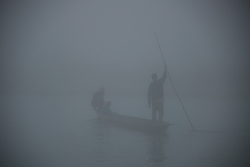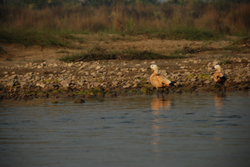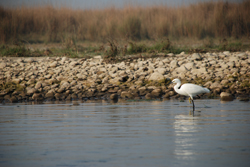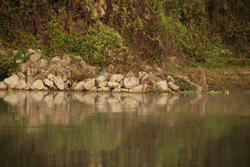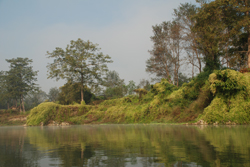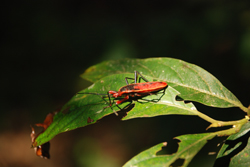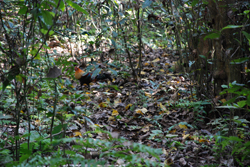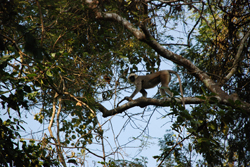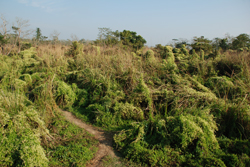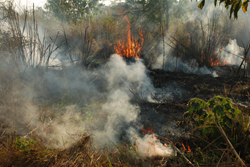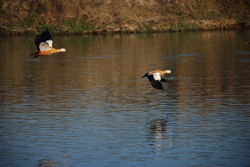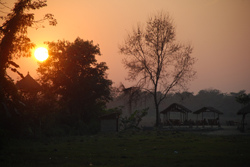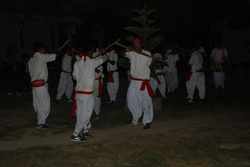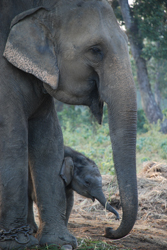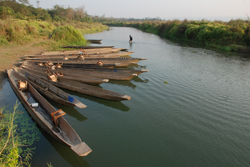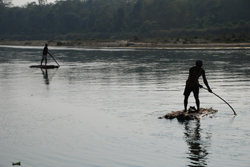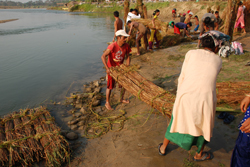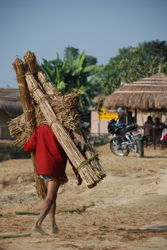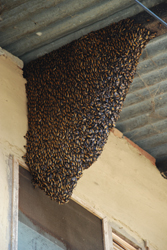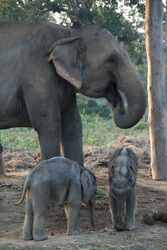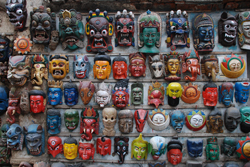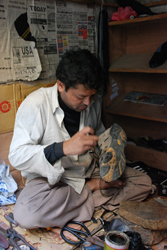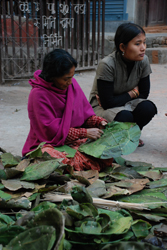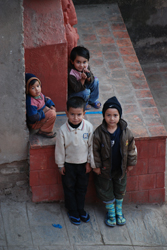Chitwan Day 2: A Walk in the Jungle
6 December, 2008, 02:16 am in "Nepal"
The morning was cloaked in a thick fog which, though beautiful, was by no means silent. As we sat waiting for breakfast, group after group of tourists came down to the beach to board one of the fleet of wooden canoes docked there. By the time the fog cleared, most of the tourists had cleared out as well.
We went with our guide, Ousa, and 2 other Americans, Steve and Ann, who we met yesterday going to the Elephant Breeding Center. We boarded a couple canoes fastened together. There was one poleman in the back. He turned the boats and we drifted down the river. The sun burned away the fog revealing lots of birds: Ruddy shell ducks-- migrating birds from Russia and Tibet waded close to the shore or flew across the river in pairs; egrets stood with necks shot forward looking for fish; kingfishers flew by or perched in trees. A big stork stood on the shore and many other birds flew by.
We went with our guide, Ousa, and 2 other Americans, Steve and Ann, who we met yesterday going to the Elephant Breeding Center. We boarded a couple canoes fastened together. There was one poleman in the back. He turned the boats and we drifted down the river. The sun burned away the fog revealing lots of birds: Ruddy shell ducks-- migrating birds from Russia and Tibet waded close to the shore or flew across the river in pairs; egrets stood with necks shot forward looking for fish; kingfishers flew by or perched in trees. A big stork stood on the shore and many other birds flew by.
We were let off down the river a bit and our boatman then had the hard job of walking, kicking and poling the boat back upstream. We headed into the jungle.
There didn't seem to be a set path from point A to B but rather a series of winding trails, some from people, some from animals. We saw lots of signs of
animals--piles of rhino dung, deer footprints, and holes dug by bears-- but no animals. There were lots of big red bugs. Ousa assured us they would not bite and were not poisonous-- quite a relief since they were everywhere.
animals--piles of rhino dung, deer footprints, and holes dug by bears-- but no animals. There were lots of big red bugs. Ousa assured us they would not bite and were not poisonous-- quite a relief since they were everywhere.
We did see several hornbills with bright yellow bills. Every now and then we'd come to the edge of the savanna and peek out seeking wildlife. But, we didn't see anything. Ousa said right now the grass was too long. After the grass was harvested, and some of the areas burned, it was easier to see the animals.
We wandered around the forest, occasionally crossed grasslands and settled on a path by a rivulet looking for crocodiles. Ousa took us to some typical crocodiles sunbathing places but we didn't see any. Finally we glimpsed the head of one looking like a log, before it disappeared under water.
We wandered some more and at some point I brushed against a plant which caused about 3 square inches of my arm to become covered with little red bumps which swelled up until they merged into one itchy puffy patch. Thankfully, they shrunk down after a while to small red dots. As we ducked around branches, and my arm itched and burned, I brushed off an ant and remembered I'm not very fond of jungles.
At one place, Rowshan saw a movement in the bushes. We quietly approached the area and saw.... a chicken. Technically it was a wild jungle fowl but it looked like a small rooster with lovely green and red feathers.
We wandered around the forest, occasionally crossed grasslands and settled on a path by a rivulet looking for crocodiles. Ousa took us to some typical crocodiles sunbathing places but we didn't see any. Finally we glimpsed the head of one looking like a log, before it disappeared under water.
We wandered some more and at some point I brushed against a plant which caused about 3 square inches of my arm to become covered with little red bumps which swelled up until they merged into one itchy puffy patch. Thankfully, they shrunk down after a while to small red dots. As we ducked around branches, and my arm itched and burned, I brushed off an ant and remembered I'm not very fond of jungles.
At one place, Rowshan saw a movement in the bushes. We quietly approached the area and saw.... a chicken. Technically it was a wild jungle fowl but it looked like a small rooster with lovely green and red feathers.
Finally, we saw a monkey in a tree. It wasn't like seeing a rhino or tiger, but it was refreshing to at least see a monkey in the wild. In another tree was saw a big monkey who sat sending a shower of pee from the tree and then took a dump. Steve wryly remarked, “We've seen so much animal poo it is nice to see it actually being created.”
From a viewing tower, we saw how an invasive South African plant had taken over the savanna transforming clumps of grass and trees into vine covered topiary sculptures. Another part of the savanna was slowly burning.
We walked back out and were on the river bank a little ways up river from the hotel. Ruddy shell ducks flew above the water. A canoe took us across the river back to the hotel.
Tonight there was a Tharu cultural performance of the stick dance. The bamboo stick dances involved groups of dancers in different formations doing dance steps and swinging bamboo sticks so they would hit other dancers' sticks. If a dancer was off it would mean someone could get whacked with a bamboo stick. There was also an excellent firedance. The dances were accompanied by a drum, which along with the costumes made me think of Bhangra music.
Chitwan Day 1: Bamboo Grass Harvest and Elephant Twins
5 December, 2008, 02:16 am in "Nepal"
The mountains disappeared in the distance and we were in a tropical flatland, reminiscent of the Amazon. We passed villages and large fields of yellow mustard flowers where women in maroon, red, and purple saris walked like a scene from a Bollywood film.
Every year for just 3 days villagers are allowed into Chitwan National Park to harvest reeds. We had arrived during that time so the park was very busy. At first I was annoyed since it meant there would be lots of people. But as we stood on the shore watching the action, I thought we were lucky to be seeing this cultural activity. The hotel is located on the river and the main beach was the scene of lots of activity. Men stood at the ends of long wooden canoes ferrying people across the river, looking a bit like Venetian gondoliers with their long wooden poles.
Every year for just 3 days villagers are allowed into Chitwan National Park to harvest reeds. We had arrived during that time so the park was very busy. At first I was annoyed since it meant there would be lots of people. But as we stood on the shore watching the action, I thought we were lucky to be seeing this cultural activity. The hotel is located on the river and the main beach was the scene of lots of activity. Men stood at the ends of long wooden canoes ferrying people across the river, looking a bit like Venetian gondoliers with their long wooden poles.
Other men floated down the river on rafts made from newly harvested reeds or walked through the water pushing huge piles of floating reeds. On the beach in front of the hotel, the rafts were cut apart. Women and men carried the bundles away, sometimes loading them on bicycles but often just carrying them up the road by hand. The reeds, called bamboo grass were about 6ft tall though they could grow to 22 feet. They are used for houses but also are sold to paper factories. 100,000 villagers collect the reeds.
In spite of all the activity, the village has a relaxed air to it. The sun is warm and air tropically balmy. The colors are dusty blue and green. The trees are thick but low. The river drifts by and maybe watching people hard at work makes one realize how much we are relaxing. A cool breeze blows.
The wildest thing we've seen so far is a huge bees nest outside our bathroom window. The swarm is about 2 feet long. There are at least 8 inches of it that is just solid bees hanging onto each other. It makes for interesting viewing while sitting on the toilet. Fortunately, there is a screen between us and them.
The wildest thing we've seen so far is a huge bees nest outside our bathroom window. The swarm is about 2 feet long. There are at least 8 inches of it that is just solid bees hanging onto each other. It makes for interesting viewing while sitting on the toilet. Fortunately, there is a screen between us and them.
Later we visited the elephant breeding center where we saw baby elephant twins. All the adult elephants in the center are female. They mate with wild bull elephants that are excluded from the main herd (which only has one male to a group of females). So the Elephant Breeding Center also serves as a brothel for loser wild elephants. The baby elephants wander freely but the older ones are chained. One baby walked out of the pen and was soon surrounded by eager admirers. The elephants sway back and forth. I thought this seemed kind of neurotic but our guide said they just wanted their elephant treats.
We finished the day with a short walk in the forest to a small pond. There were some cranes and we heard a lots of bird calls. The pond was quiet and still. In the distance we heard the sound of a barking deer.
Kathmandu:Rowshan Gets His Shoes Repaired
4 December, 2008, 03:43 am in "Nepal"
I should mention that last week there was a terrorist attack in Mumbai. For us, the freaky thing was that if we hadn't been unable to get an Indian visa in Iran, we most likely would have been in Mumbai. Since Mumbai was closer to the South than New Delhi and the airfare was the same, I had suggested flying there. We'd like to thank the Indian consulate in Tehran for changed our plans for us.
Rowshan got his shoes repaired and understands how I felt when I got mine repaired in Osh. We couldn't find a shoe repair guy in Thamel (duh!) so we walked South past Durbar Square. Rowshan asked a woman selling shoes if she knew where to repair shoes. She pointed ˝ block down the street. There we found a man sitting crosslegged in a small shop stitching a pair of sports shoes. The shop was about 8ft by 4ft with the front made of wooden doors opening onto the street. In one corner was a sewing machine. He sat with his tools all within easy reach. Rowshan showed him his shoes which were torn between the sole and upper. The cobbler said for 100rs (about $1.50) he would patch them and it would take about 10 minutes. Rowshan stood outside the shop, since there wasn't room inside for customers. I went for a walk and when I came back, the man had one of Rowshan's shoes supported on his upturned bare foot while he worked a needle through the tough edge of the sole and the the leather patch. The shoes were soon patched up. I had found a sambosa, pakora and fried curried potato puff maker so we had a delightful lunch of greasy but tasty Indian street food.
Down the street we saw a woman making bowls and plates by sewing leaves. These are Nepal's disposable dishes and I think they are a great idea. If only they weren't so labor intensive.
We ate sitting at the top of the Jaisi Deval temple. Some kids gathered round and asked Rowshan for a photo. Then one kid begged for “one dollar”. Rowshan responded “Give me 10 rupees!” The kids were taken aback by having a “rich foreigner” respond in that way and drifted off. Maybe it taught them how annoying it is...but I doubt it. One boy remained hovering nearby. When we finished eating, and Rowshan finished his soda, the boy asked for the bottle. Rowshan was willing to oblige (It's not like we'd be able to recycle it!) and we were pleased to see the kid start playing with it. Of course it is sad that a kid has to content himself with playing with a bottle instead of a soccer ball, but one has to admire his resourcefulness. Below us the kids who had descended to street level begged for a photo. Rowshan took one and it was worth it to see them scramble up the big shrine steps to see it.
Powered by My Blog 1.69. Copyright 2003-2006 FuzzyMonkey.net.
Created by the scripting wizards at FuzzyMonkey.net..
(Code modified by Rowshan Dowlatabadi)
Created by the scripting wizards at FuzzyMonkey.net..
(Code modified by Rowshan Dowlatabadi)


